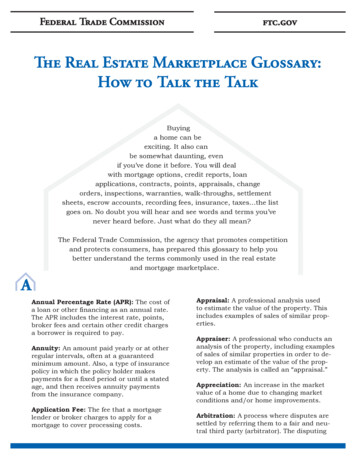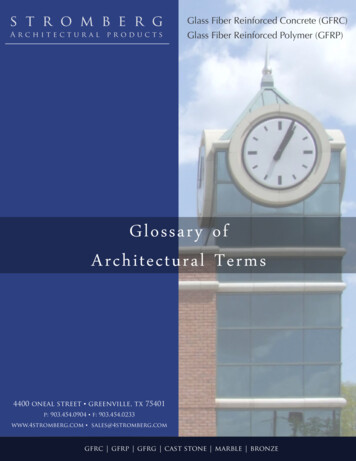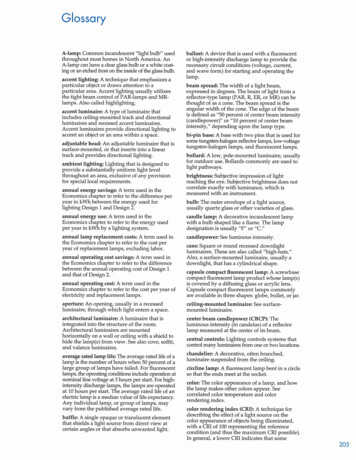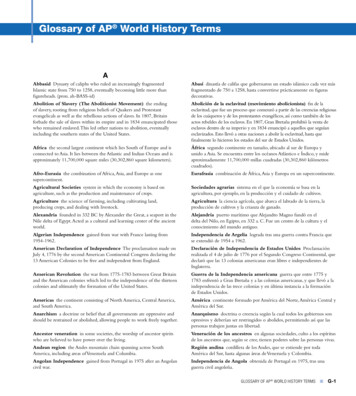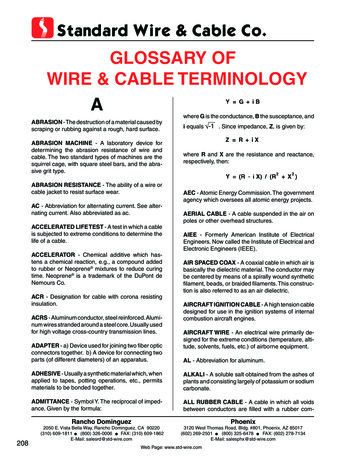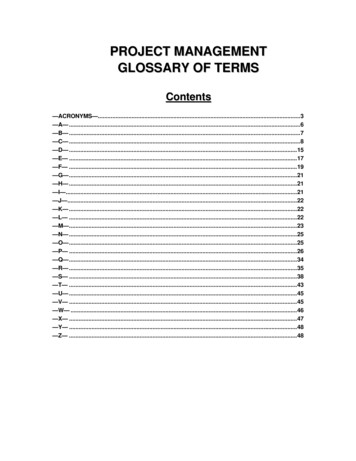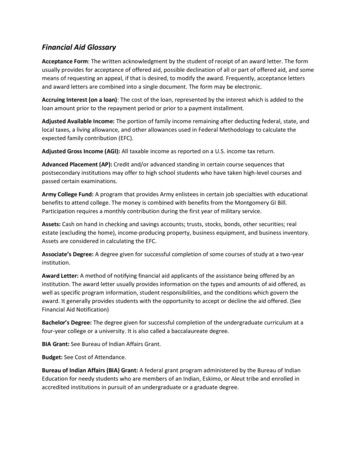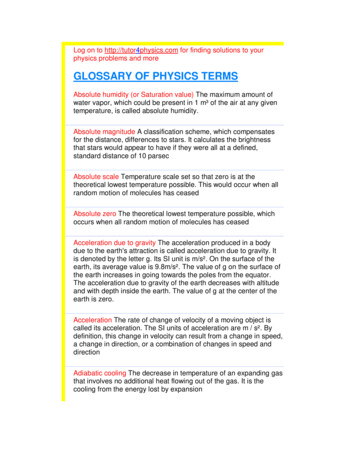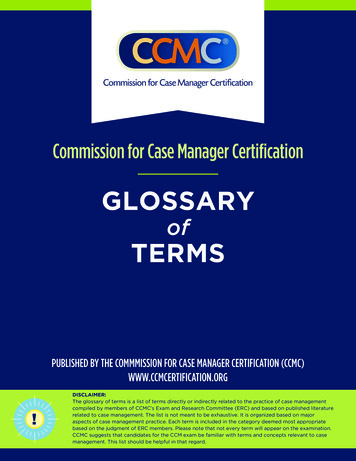
Transcription
Commission for Case Manager CertificationGLOSSARYofTERMSPUBLISHED BY THE COMMMISSION FOR CASE MANAGER CERTIFICATION (CCMC)WWW.CCMCERTIFICATION.ORGDISCLAIMER:The glossary of terms is a list of terms directly or indirectly related to the practice of case managementcompiled by members of CCMC’s Exam and Research Committee (ERC) and based on published literaturerelated to case management. The list is not meant to be exhaustive. It is organized based on majoraspects of case management practice. Each term is included in the category deemed most appropriatebased on the judgment of ERC members. Please note that not every term will appear on the examination.CCMC suggests that candidates for the CCM exam be familiar with terms and concepts relevant to casemanagement. This list should be helpful in that regard.
TERMDEFINITIONAAPM&RAmerican Academy of Physical Medicine and RehabilitationACCESS TO CAREThe ability and ease of clients to obtain healthcare when they need it.ACCESSIBLEA term used to denote building facilities that are barrier-free thus enabling allmembers of society safe access, including persons with physical disabilities.ACCOUNTABLE CAREORGANIZATION (ACO)A set of healthcare providers including primary care physicians, specialists, andhospitals that work together collaboratively and accept collective accountabilityfor the cost and quality of care delivered to a population of patients. ACOsbecame popular in the Medicare fee-for-service benefit system as a result ofthe Affordable Care Act. ACOs are formed around a variety of existing types ofprovider organizations such as multispecialty medical groups, physician-hospitalorganizations (PHO), and organized or integrated delivery systems (accountablecare facts, available at -anaccountable-care-organization-aco-1, accessed 2/16/2014).ACCREDITATIONA standardized program for evaluating healthcare organizations to ensure aspecified level of quality, as defined by a set of national industry standards.Organizations that meet accreditation standards receive an official authorizationor approval of their services. Accreditation entails a voluntary survey process thatassesses the extent of a healthcare organization’s compliance with the standardsfor the purpose of improving the systems and processes of care (performance)and, in so doing, improving client outcomes.ACTIONABLE TORTA legal duty, imposed by statute or otherwise, owing by defendant to the oneinjured.ACTIVE LISTENINGA structured way of communication and interacting in which one is activelyengaged with the speaker primarily through focused attention and suspensionof one’s own frame of reference, biases, distractions and judgment. Acommunication technique that improves personal relationships, fostersunderstanding, and facilitates cooperation and collaboration and eliminatesconflict.ACTIVITIES OF DAILY LIVING(ADLS)Routine activities an individual tends to do every day for self-care and normalliving. These include eating, bathing, grooming, dressing, toileting, transferring(such as walking, bed to chair) and continence. Assessment of an individual’sability to perform these ADLs is important for determining an individual’s ability,independence, disability or limitations. This assessment determines the typeof long-term care and benefit coverage the individual needs. care may includeplacement in a nursing home, skilled care facility or home care services.Benefitcoverage may include Medicare, Medicaid or long-term care insurance.ACTIVITY LIMITATIONSDifficulties an individual may have in executing activities. An activity limitationmay range from a slight to a severe deviation in terms of quality or quantity inexecuting the activity in a manner or to the extent that is expected of peoplewithout the health condition.1 CCMC Glossary of Terms
TERMDEFINITIONACTUAL VALUEAlso referred to as real value. Measures the worth one derives from using orconsuming a good, product, service or an item, and represents the utility of thegood, product, service, or item.ACTUARIAL STUDYStatistical analysis of a population based on its utilization of healthcare servicesand demographic trends of the population. Results used to estimate healthcareplan premiums or costs.ACTUARYA trained insurance professional who specializes in determining policy rates,calculating premiums, and conducting statistical studies.ACUITYComplexity and severity of the client’s health/medical condition.ACUTE CAREThe acute care delivery systems focus on treating sudden and acute episodesof illness such as medical and surgical management or emergency treatment,which otherwise cannot be taken care of in a less intense care setting. Acutecare settings may include hospitals, acute rehabilitation centers, emergency care,transitional hospitals, and follow-up long-term disease management settings.ADAAmericans with Disabilities Act of 1990ADA AMENDMENTS ACT(ADAAA)Americans with Disabilities Act Amendments Act of 2008ADLActivities of Daily Living. Routine activities carried out for personal hygiene andhealth and for operating a household. ADLs include feeding, bathing, showering,dressing, getting in or out of bed or a chair, and using the toilet.ADAPTIVE BEHAVIORThe effectiveness and degree to which an individual meets standards of selfsufficiency and social responsibility for his/her age-related cultural group.ADHERENCE“The extent to which a person’s behaviour--taking medication, following a diet,and/or executing lifestyle changes, corresponds with agreed recommendations[e.g., health regimen] from a health care provider” (Sabate, 2003).ADHESIVE CONTRACTA contract between two parties where one party with stronger bargaining powersets the terms and conditions and the other party, which is the weaker of the twowith little to no ability to negotiate, must adhere to the contract and is placed ina “take it or leave it” position (Cornell University Law School, Legal InformationInstitute, https://www.law.cornell.edu/wex/adhesion contract contract ofadhesion, accessed 6/4/2015).2 CCMC Glossary of Terms
TERMDEFINITIONADJUSTED CLINICAL GROUP (ACG) SYSTEM:Developed by the School of Public Health at Johns Hopkins University, this systemclusters clients into homogenous groups (102 discrete groups) based on a uniqueapproach to measuring morbidity to ultimately improve accuracy and fairnessin evaluating healthcare provider performance, identifying clients at high risk,forecasting healthcare utilization, and setting equitable payment structure andrates for the providers of care. The System accounts for the burden of morbidityin a client population based on disease patterns, age, and gender and relies onthe diagnostic and/or pharmaceutical code information found in insurance claimsor other computerized client health records (The Johns Hopkins University, 2010,retrieved from http://www.acg.jhsph.org/index.php?option com content&view article&id 46&Itemid 366ADJUSTERA person who handles claims (also referred to as Claims Service Representative).ADLSSee activities of daily living.ADMINISTRATIVE LAWThat branch of public law that deals with the various organizations of federal,state, and local governments which prescribes in detail the manner of theiractivities.ADMINISTRATIVE SERVICESONLY (ASO)An insurance company or third party administrator (TPA) that deliversadministrative services to an employer group. This usually requires the employerto be at risk for the cost of healthcare services provided, which the ASOprocesses and manages claims.ADMISSION CERTIFICATIONA form of utilization review in which an assessment is made of the medicalnecessity of a client’s admission to a hospital or other inpatient facility. Admissioncertification ensures that clients requiring a hospital-based level of care andlength of stay appropriate for the admission diagnosis are usually assigned andcertified and payment for the services are approved.ADMISSION REVIEWA review that occurs within 24 hours of a client’s admission to a healthcarefacility (e.g., a hospital) or according to the time frame required in the contractualagreement between the healthcare provider and the health insurance plan. Thisreview ensures that the client’s care in an inpatient setting is necessary, based onthe client’s health condition and intensity of the services needed.ADVANCE DIRECTIVELegally executed document that explains the client’s healthcare related wishesand decisions. It is drawn up while the client is still competent and is used if theclient becomes incapacitated or incompetent.ADVERSE EVENTSAny untoward occurrences, which under most conditions are not naturalconsequences of the client’s disease process or treatment outcomes.ADVOCACYThe act of recommending, pleading the cause of another; to speak or write infavor of. (CMSA Standards of Practice, 2010, p 24)ADVOCATEA person or agency who speaks on behalf of others and promotes their cause.AFFECTThe observable emotional condition of an individual at any given time.3 CCMC Glossary of Terms
TERMDEFINITIONAFFIDAVITA written statement of fact signed and sworn before a person authorized toadminister an oath.AGGREGATED DIAGNOSISGROUPS (ADGS)A grouping of diagnosis codes that are similar in terms of severity and likelihoodof persistence in a client’s health condition over time. An individual client cansuffer more than one health condition and therefore may have more than oneADG (total of 32 ADG clusters). Individual diseases or conditions are placedinto a single ADG based on a set of criteria including likely persistence ofdiagnosis, severity of illness, etiology, diagnostic certainty, and need for specialtycare interventions. This system was developed by the Bloomberg School ofPublic Health at Johns Hopkins University (The Johns Hopkins University,2010, retrieved from http://www.acg.jhsph.org/index.php?option comcontent&vie w article&id 55:describing-morbidity- burden&catid 37:systemcomponents&Itemid 315AGREED MEDICALEXAMINATIONAn evaluation conducted by a provider who is selected by agreement between aninjured workers’ attorney and the insurance claims administrator and/or attorney.The parties agree to conduct a medical examination and prepare a medical- legalreport to help resolve an existing dispute. The evaluation also serves to determinewhat portions of the work-related injury have contributed to the disability andwhat portions have resulted from other sources or causation.AHAAmerican Heart AssociationAHRQAgency for Healthcare Research and QualityALGORITHMThe chronological delineation of the steps in, or activities of, client care to beapplied in the care of clients as they relate to specific conditions/situations.ALTERNATE LEVEL OF CAREA level of care that can safely be used in place of the current level anddetermined based on the acuity and complexity of the client’s condition and thetype of needed services and resources.AMAAmerican Medical AssociationAMBULATORY PAYMENTCLASSIFICATION (APC)SYSTEMAn encounter-based classification system for outpatient reimbursement, includinghospital-based clinics, emergency departments, observation, and ambulatorysurgery. Payment rates are based on categories of services that are similar in costand resource utilization.ANAAmerican Nurses AssociationANCCAmerican Nurses Credentialing CenterANCILLARY SERVICESOther diagnostic and therapeutic services that may be involved in the care ofclients other than nursing or medicine. Includes respiratory, laboratory, radiology,nutrition, physical and occupational therapy, and pastoral services.APCSee ambulatory payment classification.4 CCMC Glossary of Terms
TERMDEFINITIONAPPEAL (CARE PROVISIONRELATED)The formal process or request to reconsider a decision made not to approvean admission or healthcare services, reimbursement for services rendered, or aclient’s request for postponing the discharge date and extending the length ofstay.APPEAL (LEGAL IN NATURE)The process whereby a court of appeals reviews the record of written materialsfrom a trial court proceeding to determine if errors were made that might lead toa reversal of the trial court’s decision.APPROPRIATENESS OFSETTINGUsed to determine if the level of care needed is being delivered in the mostappropriate and cost-effective setting possible.APPROVALto offer or receive affirmation, sanction, or agreement about a decision, action,service, treatment, or intervention. In the area of health insurance, it is theact of authorizing or affirming a service to a client that implies agreement toberesponsible for reimbursing the provider of the service the related cost ofproviding the service to a client/support system.APPROVED CHARGEThe amount Medicare pays a physician based on the Medicare fee schedule.Physicians may bill the beneficiaries for an additional amount, subject to thelimiting charge allowed.ASOSee administrative services only.ASSESSINGThe process of collecting in-depth information about a client and her/his supportsystem in order to identify the needs and decide upon the best case managementservices to address these needs. Similar to screening, however to a greater depth.ASSESSMENTThe process of collecting in-depth information about a person’s situation andfunctioning to identify individual needs in order to develop a comprehensivecase management plan that will address those needs. In addition to direct clientcontact, information should be gathered from other relevant sources (patient/client, professional caregivers, non-professional caregivers, employers, healthrecords, educational/military records, etc.).ASSIGNMENT OF BENEFITSPaying medical benefits directly to a provider of care rather than to a member.This system generally requires either a contractual agreement between the healthplan and provider or written permission from the subscriber for the provider to billthe health plan.ASSISTIVE DEVICEAny tool that is designed, made, or adapted to assist a person to perform aparticular task.ASSISTIVE TECHNOLOGYAny item, piece of equipment, or product system, whether acquired commerciallyor off the shelf, modified, or customized, that is used to increase, maintain, orimprove functional capabilities of individuals with disabilities.ASSISTIVE TECHNOLOGYSERVICESAny service that directly assists an individual with a disability in the selection,acquisition, or use of an assistive technology device.5 CCMC Glossary of Terms
TERMDEFINITIONASSUMPTION OF RISKA doctrine based upon voluntary exposure to a known risk. It is distinguishedfrom contributory negligence, which is based on carelessness, in that it involves acomprehension that a peril is to be encountered and a willingness to encounter it.ASSURANCE/INSURANCEThe term assurance is used more commonly in Canada and Great Britain. The terminsurance is the spreading of risk among many, among whom few are likely tosuffer loss. The terms are generally accepted as synonymous.AUTHORIZATIONThe approval of client care services, admission, or length of stay by a healthbenefit plan (e.g., HMO, PPO) based on information provided by the healthcareprovider.AUTONOMYAgreement to respect another’s right to self-determine a course of action; supportof independent decision making. (Beauchamp, T.L. & Childress, J.F. Principles ofBiomedical Ethics, 6th Ed. 2009, NY, NY; Oxford University Press, p 38-39)BAD FAITHGenerally involving actual or constructive fraud, or a design to mislead or deceiveanother.BARRIER-FREEA physical, manmade environment or arrangement of structures that is safe andaccessible to persons with disabilities.BARRIERSFactors in a person’s environment that, if absent or present, limit one’s functioningand create disability. Examples are a physical environment that is inaccessible,lack of relevant assistive technology, and negative attitudes of people towarddisability. Barriers also include services, systems, and policies that are eithernonexistent or that hinder the involvement of people with a health condition inany area of life.BASBurden Assessment ScaleBENCHMARKINGAn act of comparing a work process with that of the best competitor. Throughthis process one is able to identify what performance measure levels must besurpassed. Benchmarking assists an organization in assessing its strengths andweaknesses and in finding and implementing best practices.BENEFICENCECompassion; taking positive action to help others; desire to do good; coreprinciple of client advocacy. (Beauchamp, T.L. & Childress, J.F. Principles ofBiomedical Ethics, 6th Ed. 2009, NY, NY; Oxford University Press, p 38-39)BENEFICIARYAn individual eligible for benefits under a particular plan. In managed careorganizations beneficiaries may also be known as members in HMO plans orenrollees in PPO plans.BENEFIT PACKAGEThe sum of services for which a health plan, government agency, or employercontracts to provide. In addition to basic physician and hospital services, someplans also cover prescriptions, dental, and vision care.6 CCMC Glossary of Terms
TERMDEFINITIONBENEFIT PROGRAMSgovernment agency, or employer to individuals based on some sort of anagreement between the parties; for example between an employer and anemployee. Benefits vary based on the plan and may include physician and hospitalservices, prescriptions, dental and vision care, workers’ compensation, long-termcare, mental and behavioral health, disability and accidental death, counseling andother therapies such as chiropractor care.BENEFITSPrincipal Term: The type of health and human services covered by an insurancecompany/health plan and as agreed upon between the plan/insurance companyand the individual enrollee or participant. Benefits also refers to the amountpayable by an insurance company to a claimant or beneficiary under theclaimant’s specific coverage as stipulated in the agreed upon health plan.BEYOND (OUTSIDE)-THEWALLS CASE MANAGEMENTModels where healthcare resources, services and case managers are basedexternally to an acute care/hospital setting, that is in the community.BOARD-CERTIFIED CASEMANAGERA case manager who has earned the certified case manager (CCM) credentialoffered by the Commission for Case Manager Certification (CCMC). This involvespassing an evidence-based certification examination after meeting a set of criteriathat qualifies the case manager to sit for the examination. Once certified, thecase manager must maintain the certification by acquiring ongoing educationthrough means of continuing education units (CEUs), and uphold the CCM Codeof Professional Conduct for Case Managers.BODY OF KNOWLEDGE (BOK)Widely recognized information, standards, methods, tools, and practices abouta specific field. A BOK usually includes a comprehensive set of concepts,terms, tools, and activities that make up a profession, as defined by a relevantprofessional society. While the term body of knowledge is used to describethe document that defines that knowledge, the body of knowledge itself is adynamic reference that “is more than simply a collection of terms and concepts;a professional reading list; a library; a website or a collection of websites; adescription of professional functions; or even a collection of information”(Wikipedia, 2010). Therefore, one may then describe a BOK as a prescribedaggregation of essential knowledge in a particular field or specialty an individualwithin the field is expected to have mastered to effectively practice and beconsidered a practitioner within the specialty (Babylon Online Dictionary, 2009).BOKSee body of knowledge.BONA FIDELiterally translated as “in good faith.”BRAIN DISORDERA loosely used term for a neurological disorder or syndrome indicatingimpairment or injury to brain tissue.BRAIN INJURYAny damage to tissues of the brain that leads to impairment of the function of theCentral Nervous System.BURDEN OF PROOFThe duty of producing evidence as the case progresses, and/or the duty toestablish the truth of the claim by a preponderance of the evidence. The formermay pass fro
APPEAL (LEGAL IN NATURE) The process whereby a court of appeals reviews the record of written materials from a trial court proceeding to determine if errors were made that might lead to a reversal of the trial court’s decision. APPROPRIATENESS OF SETTING Used to determine i


